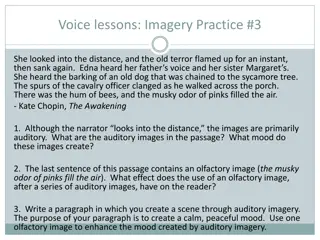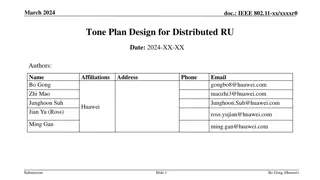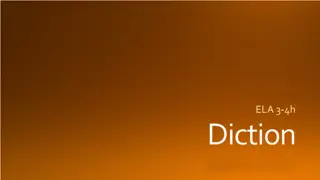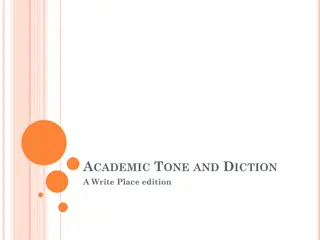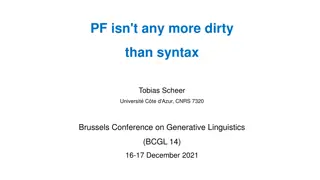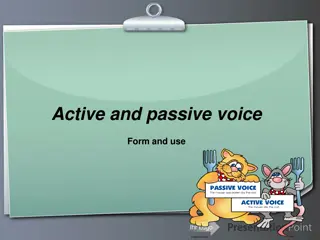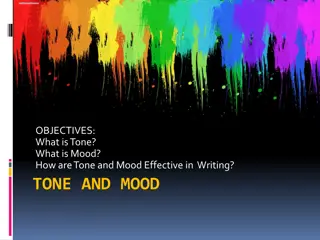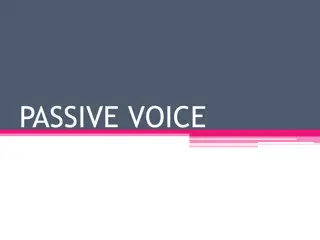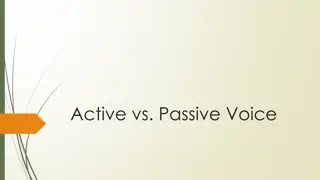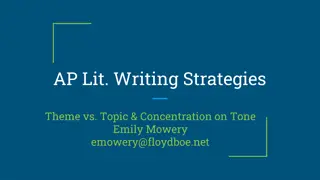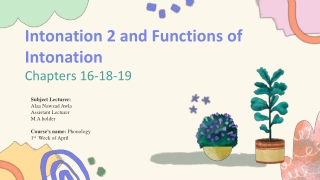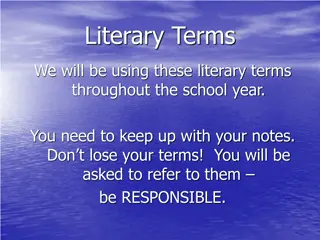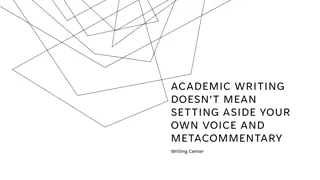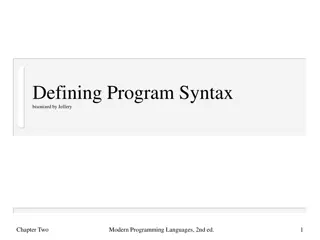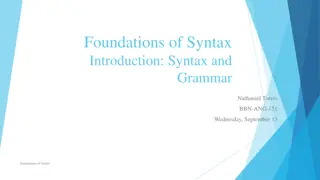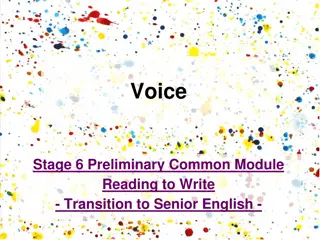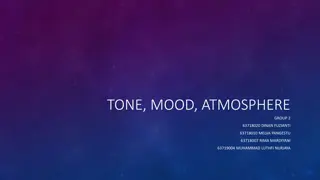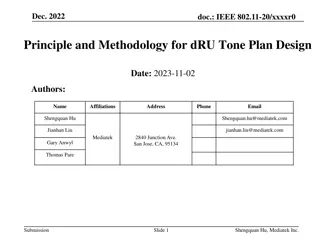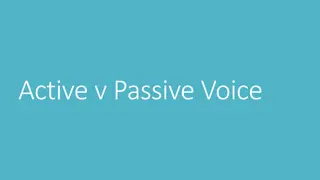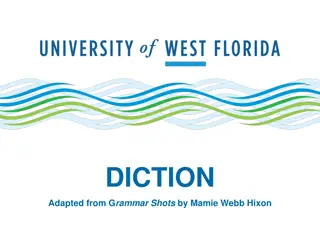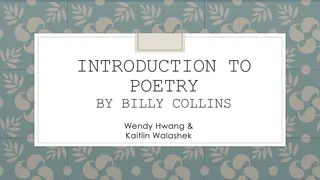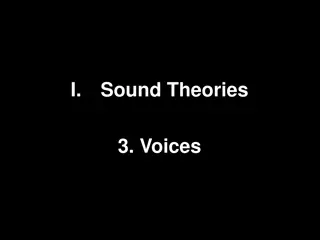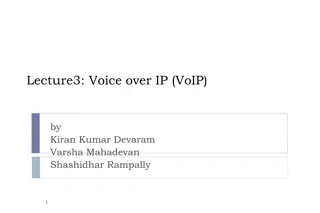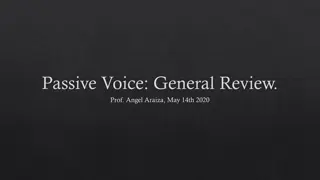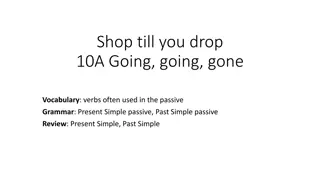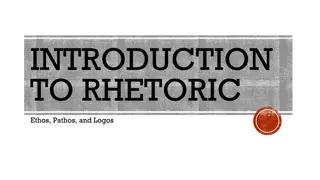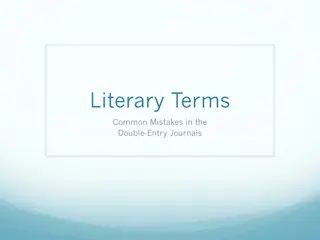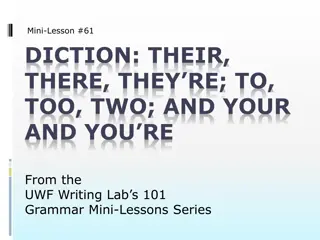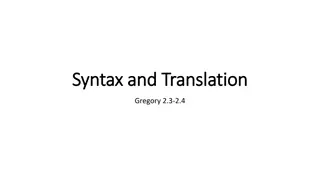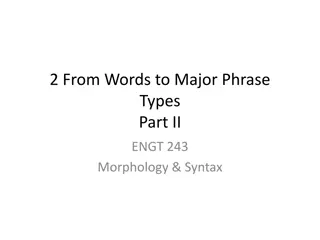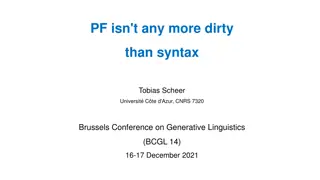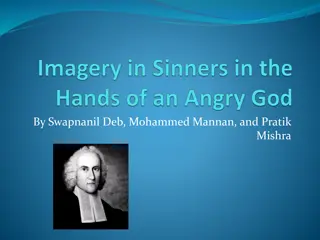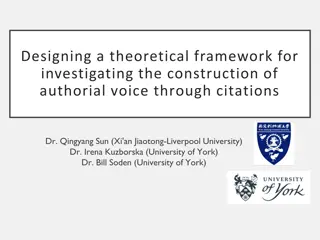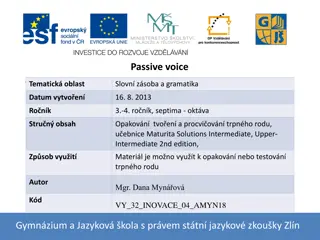Mastering Voice in Writing: Diction, Detail, Imagery, Syntax, and Tone
Enhance your writing by mastering the elements of voice - diction, detail, imagery, syntax, and tone. Discover how word choice shapes effective communication and learn the importance of clarity and precision in creating impactful writing.
Download Presentation

Please find below an Image/Link to download the presentation.
The content on the website is provided AS IS for your information and personal use only. It may not be sold, licensed, or shared on other websites without obtaining consent from the author. Download presentation by click this link. If you encounter any issues during the download, it is possible that the publisher has removed the file from their server.
E N D
Presentation Transcript
Diction Detail Imagery Syntax Tone VOICE
VOICE Effective voice is shaped by words that are clear, concrete, and exact. Good writers eschew (to avoid; to shun) words like pretty, nice, good, beautiful, fine, things, really, very, terrible, a lot, and bad. Instead they employ words that invoke a specific effect.
VOICE IS THE FINGERPRINT OF A PERSONS LANGUAGE There are 5 elements of voice: Diction Detail Imagery Syntax Tone
DICTION Diction refers to word choice. It is the foundation of voice and contributes to all of its elements. Words: Create color and texture Reflect and determine the level of formality Shape the reader s perceptions When reading serious literature, NEVER skip words you do not know! It is tantamount to wearing earplugs to a symphony.
DICTION Effective voice is shaped by words that are clear, concrete, and exact. Good writers will tell you that the door does not shut, it thuds. He is not wearing a torn coat, it is a tattered coat. Diction depends on: Topic-There is a vast difference in word choice from an article on computers and a short story by Poe. Purpose-Words are chosen to impart a particular effect: convince, entertain, amuse, inform or plead Occasion-This is the level of formality; formal (scholarly writing), informal (the norm and includes slang and colloquial diction)
DICTION Other terms that accompany the study of diction are connotation and denotation. Denotation-dictionary definition of a word. The red curtains are hanging. (red allows you to see the color of the curtains) Connotation-the meaning suggested by the word. The blood red curtains are hanging. (using blood in front of red creates a completely different feeling. Good writers make choices to balance complexity and simplicity. Good writers make choices to balance multiple meanings with precision.
DICTION Twenty bodies were thrown out of our wagon. Then the train resumed its journey, leaving behind it a few hundred naked dead, deprived of burial, in the deep snow of a field in Poland. -Elie Wiesel, Night How would the meaning change if we substituted dead people for bodies? Fifteen chickens were slaughtered for the feast. Change the word above to a word that disassociates the reader from the true action of the sentence.
USING YOUR UNDERSTAND OF SPEAK, DISCUSS THE FOLLOWING: The school bus wheezes to my corner. 1. Discuss the above bold word and its effect on the sentence. 2. Replace the bold word for a different effect. I am Outcast. 1. Add a word to the above sentence to change its effect. He s warming up for a full-fledged rant when the bell rings. Some teachers rumorwhisper he s having a breakdown. I think he s the sanest person I know. 1. Discuss the effect of the above bold word. 2. Replace the bold word for a different effect.
DETAIL Detail includes facts, observations, and incidents used to develop a subject and impart voice. Details a writer includes or excludes help shape voice. In elementary and middle school, you were asked to include as much detail as possible. As a high school student, you will be asked to choose your details carefully for analysis that do not detract or trivialize from your purpose.
DETAIL Specific details refer to fewer things than general descriptions, thereby creating a precise mental picture. However, the more specific the details are, the greater the focus on the object described. Detail brings life and color to description, focusing your attention and bringing you into a specific scene. Detail encourages you to participate in the text, use of detail influences your view on the topic, setting, narrator, and author. Detail can be an understatement by a LACK of detail. The absence of specific details, for example, may be in sharp contrast to the intensity of a character s pain. In this case, elaborate, descriptive detail could turn the pain into sentimentality.
DETAIL An old man, Don Tomasito, the baker, played the tuba. When he blew into the huge mouthpiece, his face would turn purple and his thousand wrinkles would disappear as his skin filled out. -Alberto Alvaro Rios, The Iguana Killer Compare the first two sentences. Contrast the second sentence with the following. How does it change the attitude toward Tomasito? When he blew the tuba, his face turned purple and his cheeks puffed out.
DETAIL: GEORGE ORWELL, SHOOTING THE ELEPHANT I rounded the hut and saw a man's dead body sprawling in the mud. He was an Indian, a black Dravidian coolie, almost naked, and he could not have been dead many minutes. The people said that the elephant had come suddenly upon him round the corner of the hut, caught him with its trunk, put its foot on his back and ground him into the earth. This was the rainy season and the ground was soft, and his face had scored a trench a foot deep and a couple of yards long. He was lying on his belly with arms crucified and head sharply twisted to one side. His face was coated with mud, the eyes wide open, the teeth bared and grinning with an expression of unendurable agony. (Never tell me, by the way, that the dead look peaceful. Most of the corpses I have seen looked devilish.)
DETAIL: GEORGE ORWELL, SHOOTING THE ELEPHANT What is the author s attitude toward the coolie s death? What details in the passage reveal this attitude? Examine the last sentence of this paragraph. How would it have affected the overall impact had Orwell written, his eyes wide open, his teeth bared and grinning ?
DETAIL We fall into clans: Jocks, Country Clubbers, Idiot Savants, Cheerleaders, Human Waste, Eurotrash, Future Fascists of America, Big Hair Chix, the Marthas, Suffering Artists, Thespians, Goths, Shredders. I am clanless. I wasted the last weeks of August watching bad cartoons. I didn t go to the mall, the lake, or the pool or answer the phone. I have entered high school with the wrong hair, the wrong clothes, and the wrong attitude. I don t have anyone to sit with. -Laurie Halse Anderson, Speak What does the above passage tell you about Merryweather High School? How is this an example of detail and not imagery?
IMAGERY: Imagery is the verbal representation of sensory experience and includes: Visual-sight Auditory-sound Tactile-touch Gustatory-taste Olfactory-smell Imagery depends on both diction and detail: the success in producing a sensory experience results from the specificity of the author s diction and choice of detail.
IMAGERY: Imagery includes figurative language: Visual Simile: compare using like or as Metaphor: compare without like or as Hyperbole: extreme exaggeration Extended Metaphor: a metaphor introduced and then further developed throughout all or part of a literary work, especially a poem: Robert Frost uses two roads as an extended metaphor in The Road Not Taken. Personification: giving human characteristics to an object Allusion: reference to a mythological, literary, historical, or Biblical person place or thing.
IMAGERY: In the midst of poverty and want, Felix carried with pleasure to his sister the first little white flower that peeped out from beneath the snowy ground. -Mary Shelly, Frankenstein What do you understand about Felix from the imagery of this sentence? How would the effect be different if Felix carried his sister a big bouquet of spring flowers? Write a sentence which expresses the joy of a renewal through a visual image.
IMAGERY: My tree is definitely breathing; little shallow breathes like it just shot up through the ground this morning. This one is not perfectly symmetrical. The bark is rough. I try to make it look as if initials had been carved in it a long time ago. One of the lower branches is sick. If this tree really lives someplace, that branch better drop soon, so it doesn t kill the whole thing. Roots knob out of the ground and the crown reaches for the sun tall and healthy. The new growth is the best part. -Laurie Halse Anderson, Speak What do you understand about Melinda s tree from the imagery in this passage? Which sentence describes the new growth? How does the new growth symbolize Melinda?
SYNTAX Syntax is the grammatical sentence structure. It controls the verbal pacing and the focus of the written text through word order, sentence length, sentence focus and punctuation. Most sentences follow subject/verb/object/complement pattern. Deviating from that pattern can serve to startle your reader and draw attention to the sentence, emphasizing the unusual message in the sentence. Sentence Structures Sentence Length: Telegraphic-shorter than 5 words Short-approximately 5 words Medium-approximately 18 words Long/involved-30 words or more
SYNTAX Sentence Patterns: Declarative, Imperative, Interrogative, Exclamatory Simple, Compound, Complex, Compound Complex (CC=2 or more independent clauses and one or more dependent clauses. Cumulative/Loose-a main clause that is followed by phrases and/or clauses that modify the main clause and add information. We reached Edmonton that morning after a turbulent flight and some exciting experiences. Periodic Sentence-makes sense only when the end of the sentence is reached. That morning, after a turbulent flight and some exciting experiences, we reached Edmonton. Balanced-phrases or clauses balance each other in likeness, structure, meaning and/or length. Buy a bucket of chicken and have a barrel of fun.
SYNTAX Sentence Patterns: Natural Order-subject, predicate Inverted-predicate, subject Split order-predicate, subject, predicate In California oranges grow. Parallel Structure- grammatical or structural similarity between sentences or parts of a sentence involving arrangement of words, phrases, sentences, and paragraphs so that elements of equal importance are equally developed and similarly phrased. A sentence, article, chapter, and even book can be written in parallel structure. Parallel denotes equality. Juxtaposition-a poetic and rhetorical device which normally unassociated ideas, words, or phrases are placed next to one another, creating an effect of surprise. It was the best of times, it was the worst of times
SYNTAX I slowed still more, my shadow pacing me, dragging its head through the weeds that hid the fence. -William Faulker, The Sound and the Fury In this sentence, form imitates meaning. How does Faulkner slow the sentence down, reinforcing the sentence s meaning? How would this impact the sentence? I slowed still more. My shadow paced me and dragged its head through the weed- obscured fence. Write a sentence that expresses reluctance. Use at least two phrases and one subordinate clause to reinforce the meaning of your sentence.
SYNTAX When I am too sad and too skinny to keep keeping, when I am a tiny thing against so many bricks, then it is I look at trees. -Sandra Cisneros, The House on Mango Street What kind of grammatical structure is repeated in the above sentence and what is the effect? I am Outcast. -Laurie Halse Anderson, Speak What type of sentence is this and what effect does it have on the text? I have survived. I am here. Confused, screwed up, but here. So, how can I find my way? Is there a chain saw of the soul, an ax I can take to my memories or fears? -Laurie Halse Anderson, Speak Using diction, details, imagery, and syntax, dissect the above.
TONE Tone is the writer s or speaker s attitude towards their subject, audience, or self; emotion coloring or emotional meaning of a work. When a person is speaking, it is easy to notice the tone of voice. An author must rely on other techniques to show tone: diction, detail, images, and syntax. Diction, detail, imagery, and syntax create the author s tone. Tone is the key to understanding the author s intentions and feelings. TONE IS NOT MOOD. It is important to describe the tone in as precise of diction as possible. The tone can never be happy but instead elated, pleased friendly An analysis of tone will depend on our precise and accurate understanding of the author s attitude toward *the subject *the audience
TONE DIDLS D-diction (word choice) I-imagery (vivid appeal to the senses) D-detail (concrete and literal facts) L-language (the overall use of language in the entire piece, not just isolated diction as with connotation. These words qualify how a work is written, not tone or attitude. Some examples are: jargon, scholarly, informal, precise, literal, colloquial, formal, picturesque, obscure ) S-Syntax (sentence structure)
TONE And I start to play. It was so beautiful. I was so caught up in how lovely I looked that at first I didn t worry how I would sound. So it was a surprise to me when I hit the first wrong note and I realized something didn t sound quite right. And then I hit another and another followed that. A chill started at the top of my head and began to trickle down. Yet I couldn t stop playing, as though my hands were bewitched. I kept thinking my fingers would adjust themselves back, like a train switching to the right track. I played this strange jumble through two repeats, the sour notes staying with me all the way to the end. -Amy Tan The Joy Luck Club How does the narrator s attitude toward her performance change in the passage? How does the author s use of detail, diction, and imagery reveal the narrator s changing attitude?
TONE Shug come over and she and Sofia hug. Shug say, Girl, you look like a good time, you do. That when I notice that Shug talk and act sometimes like a man. Men say stuff like that to women, Girl, you look like a good time. Women always talk bout hair and health. How many babies living or dead, or got teef. Not bout how some woman they hugging on look like a good time. -Alice Walker The Color Purple What is the speaker s attitude toward Shug? Walker repeats the phrase, look like a good time, three times in the passage. How does this use of repetition help create the tone of the passage?
TONE This is where you can find your soul if you dare. Where you can touch that part of you that you've never dared look at before. Do not come here and ask me to show you how to draw a face. Ask me to help you find the wind. -Laurie Halse Anderson Speak What is the speaker s attitude toward its subject? I know my head isn't screwed on straight. I want to leave, transfer, warp myself to another galaxy. I want to confess everything, hand over the guilt and mistake and anger to someone else. There is a beast in my gut, I can hear it scraping away at the inside of my ribs. Even if I dump the memory, it will stay with me, staining me. My closest is a good thing, a quiet place that helps me hold these thoughts inside my head where no one can hear them. -Laurie Halse Anderson Speak What is the speaker s attitude toward its subject?


